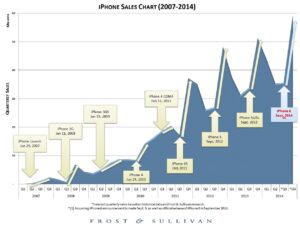Hello! And welcome to our Friday column, Worst of the Week. There’s a lot of nutty stuff that goes on in this industry, so this column is a chance for us at RCRWireless.com to rant and rave about whatever rubs us the wrong way. We hope you enjoy it!
And without further ado:
I would like to think that I have become immune to the hyperbole that seems to spew from the wireless industry on a daily basis. Terms like “best,” “world’s first” and “industry leading” pass through what’s left of my mind at lightning speed, at this point barely registering enough to elicit an eye roll.
However, we are now just days away from Apple once again altering the reality of the mobile space, with expectations that the company will announce its latest iPhone iteration at an intimate event on Sept. 9. While I have become somewhat aloof in terms of covering iPhone-related news as my life is not tied to iTunes, I also realize the dramatic impact Apple’s smartphone has had on the mobile space, and thus on my life.
The original iPhone obviously had the biggest impact, with just about every move made by a wireless-related company having to be clarified by being either pre-2008 or post-2008. (I know the iPhone launched in mid-2007, but initial pricing made the device still a boutique item. Once Apple and its carrier partner AT&T Mobility realized this and slashed pricing later in 2007, the iPhone began to flood the market and thus it was not until late 2007 that the real impact of the device was felt.)
I can still remember running by several Apple stores the morning of that first launch just to check out the crowds of people waiting for the doors to open. Later that day I even ran by a store and picked up an iPhone as RCR Wireless News was not on the “select” list of “friendly” publications deemed worthy of a demonstration model. And thanks to Apple’s return policy, RCR Wireless News was able to play around with that first device for 14 days before it was summarily returned to said Apple outlet. No harm, no foul.
The next iteration, dubbed the iPhone 3G, had a similar monumental impact on the market as now customers could access a faster wireless network and take advantage of the larger screen size the iPhone offered. This was also the beginning of AT&T’s network headaches, with iPhone usage crippling the carrier’s still nascent 3G network in a number of high-profile markets, an image that stayed with consumers for years.
The iPhone 4 continued Apple’s dominance in the device space, as despite competitors finally beginning to launch comparable devices, the redesign of the iPhone platform kept Apple well above its rivals. Sure, antenna engineers had problems with the all-glass confines, but that did not take anything away from consumer demand or the device’s impact. Apple attempted to milk that success with its iPhone 4S update, but the improvements were too minor for most to understand and thus took a bit of luster off of Apple’s crown.
With rivals rolling out competitors in all shapes and sizes, Apple made a significant move with the iPhone 5 by slightly enlarging its screen from 3.5-inches to four inches, thus allowing the aging populace to better see what the hell all the fuss was about. As with the iPhone 4S “update” Apple lightly glazed the 5S with enhanced features, with the most compelling being a fingerprint scanner. Apple also managed to throw the low end of the market a bone by rolling out the 5C model, which despite a bunch of fun colors seemed to fall off the radar screen.
All of this now leads to the expected launch of the iPhone 6, for lack of a better name. While actual facts about the device are officially nonexistent, rumors suggest another major redesign, including the most important improvement: screen size. I have already made my case that Apple needed to get with it in terms of screen size in order to combat rivals pushing the boundaries of what can comfortably fit into a pocket/purse/cup holder, and it would appear that Apple is finally making the move.
(You know it’s whatcha want.)
(I should also say I have made a case for Apple not changing the screen size at all, only for the uproar such a move would cause.)
This update alone will be what sends iPhone 6 sales through the roof. Heck, Frost & Sullivan is so sure of the roof-busting prowess of the next iPhone that they were forced to put it in chart form:
For too long, iPhone users have been somewhat ashamed to whip out their device in the company of friends/family/enemies sporting mega-screened Android-powered devices. But, with the potential for a larger-screened iPhone, consumers will no longer have to feel inferior.
(A close second in terms of what consumers really want will be battery life, which has been the bane of iPhone users since the device’s inception. I suspect they will continue to be baned. Bane!)
Consumers are not going to care about how fast the processor is, how much RAM is on the board or how many types of Wi-Fi the device supports. Screen size will be what matters and will drive crazy sales numbers for the latest iPhone.
If this move does indeed come to fruition, it will be hard to not believe the hype.
OK, enough of that.
Thanks for checking out this week’s Worst of the Week column. And now for some extras:
—Sprint may be still trying to find its way in terms of attracting humans to its network, but the carrier appears to have a head start in terms of attracting our robot friends.
Bloomberg reports that Sprint Chairman Masayoshi Son is looking to start selling his “humanoid robots named ‘Pepper’” at Sprint stores beginning next summer. (That should solve all of Sprint’s problems.) The four-foot-tall robot is expected to go on sale in Japan early next year at a price of $1,900.
According to the report, the robot “dances, makes jokes and estimates human emotions based on expressions.” I wonder if it could sense my inner rage at a robot attempting to dance, make jokes or estimate human emotions? Or better yet, will it be able to detect disappointment stemming from Sprint throwing out robots instead of beefing up its network?
—AT&T announced that its LTE network now covers 300 million potential customers, hitting a mark that seemed just out of reach following the dissolution of its attempted $39 billion acquisition of T-Mobile USA back in 2011. One aspect in justifying that deal to regulators was a claim from AT&T that it could only cover about 250 million pops with LTE services without T-Mobile USA’s spectrum.
However, thanks to throwing some of those billions of dollars at other available spectrum, AT&T was able to expand LTE coverage after all.
—Finally, I know everyone is excited about the chance to attend two trade shows in the same town next week. But, please let’s leave those roller-backpacks at home. Sure, neither CCA nor CTIA are expected to have packed show floors where thousands of attendees are reduced to cattle trying the non-navigatable, but let’s just enjoy the virtual autobahn-like experience.
I welcome your comments. Please send me an e-mail at dmeyer@rcrwireless.com.
Bored? Why not follow me on Twitter


